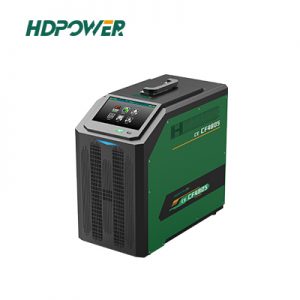Uneven cell voltages naturally develop in multi-cell lithium battery packs due to manufacturing tolerances, temperature gradients, and aging. Even identical cells drift apart over time; one cell may reach full charge or discharge before the others. This “cell imbalance” means the weakest cell limits pack capacity, forcing the system to underutilize the remaining energy. Imbalanced cells also face disproportionate stress (overcharging some cells while undercharging others), which accelerates degradation and shortens pack life. In extreme cases, severe imbalance can push cells beyond safe limits, risking thermal runaway or fire. In short, even a small voltage difference can dramatically cut usable capacity and lifespan (for example, a 10% SoC imbalance may cut capacity by ~20%).
For these reasons, engineers integrate battery balancing devices into lithium systems. A Lithium Battery Equalization Tester (also called a lithium cell equalizer or balancer) is a specialized test instrument used to diagnose and quickly correct cell-to-cell voltage differences. Unlike a passive shunt in a BMS, an active equalization tester can charge or discharge each cell individually to bring all cells to the same voltage. In practice, the tester connects to each cell of a pack (often via a multi-pin lead or fixture) and monitors all cell voltages in parallel. When it detects a mismatch, it clamps the target cell at a precise voltage and safely bleeds or adds current until the voltages equalize. By avoiding overcharge/over-discharge of any single cell, these devices eliminate the capacity lost to imbalance and greatly improve pack consistency. Battery manufacturers, EV OEMs, and service providers commonly use equalization testers after production or in field maintenance to restore full capacity and extend battery life.
Advanced Features of Modern Equalization Testers
Leading lithium equalization testers offer high-precision control and rich diagnostics. For example, state-of-the-art units achieve voltage accuracy on the order of 0.01% of full scale – about ±1 mV on a 5 V range – and current control to within ±10 mA. Multi-channel designs allow many cells to be equalized in parallel (typical models support 12–72 cells across 1–6 expandable modules). Each channel operates independently to prevent crosstalk: one cell’s balancing operation does not interfere with its neighbors. In practice, this means you can, for example, charge one cell to 3.50 V while discharging another simultaneously, without conflict.

Lithium Battery Equalizer‘s All channels feed into a central controller and user interface. A large touch-screen display (often 7″ LCD) shows each cell’s voltage, current, and state of charge in real time. Operators can program setpoints or select templates for common battery types. The tester logs data and can often export graphs or CSV files for post-analysis. Figure 1 (below) shows an equalizer’s screen during a balancing run, with each cell’s voltage and charge current visible. Note how the device shows which cells are “Complete” and which are still charging/discharging, making it easy to verify that all cells converge to the target voltage.
In addition to precision and data, modern testers incorporate safety and convenience features. Voltage clamp functionality maintains a cell at its target voltage while adjusting current. Built-in protections automatically halt the test if any cell exceeds its safe voltage or enters reverse polarity. Many systems allow on-the-fly calibration of the voltage/current sensors to ensure accuracy. Preset battery templates and one-click start make operation straightforward, even in busy workshops. Some testers also communicate over RS-485, USB or TCP/IP for remote monitoring or integration with a lab database.
| Parameter | Example: CE-CF24 (HDPOWER) |
|---|---|
| Cells Supported | 12–72 cells (1–6 × 12) |
| Voltage Range | 1.000–5.000 V |
| Current Range | 0–5 A (adjustable) |
| Voltage Accuracy | ±1 mV (5 V FS) |
| Current Accuracy | ±10 mA (5 A FS) |
| Display | 7″ LCD touchscreen |
| Communication | RS-485, USB |
Use Cases: EVs, BESS, Telecom & Manufacturing
Lithium equalizers are used wherever high-reliability packs are needed. In the automotive industry, EV manufacturers and service shops use equalization testers to diagnose and refurbish high-voltage battery modules. For instance, HDPOWER notes that automobile factories and 4S maintenance centers employ these testers to “quickly solve reduced battery life” and improve customer satisfaction. In Battery Energy Storage Systems (BESS), large stationary storage installations periodically require cell balancing to avoid runaway conditions in megawatt-scale battery stacks. An energy storage operator might schedule regular equalization cycles as part of preventive maintenance to “ensure system stability and avoid safety accidents” from accumulating imbalances.
Telecom is another important application: base stations and emergency power systems rely on battery strings (sometimes Li-ion) for backup. Equalizers help keep those backup batteries evenly charged to avoid one weak cell causing a shutdown. This technology is “suitable for a wide range of industries, including … telecommunications, and more”. In practice, a telecom maintenance crew may attach an equalization tester to a bank of cells after a grid outage or as part of routine service to ensure each cell is at equal state-of-charge.
Best Practices for Maintenance Integration
To maximize benefit, equalization should be part of a routine maintenance regimen. Experts advise monitoring cell voltages and applying an equalizing charge whenever the difference exceeds about 0.1 V. In other words, schedule balancing once imbalance crosses the threshold specified by the manufacturer or the protection circuit. It is critical to “administer [the equalizing charge] with care” – set the current conservatively and use the tester’s auto-cutoff features (over/under-voltage, reverse polarity) to prevent overcharging. Many modern testers include these protections and will automatically stop if any cell nears its limit.
Before each use, calibrate the tester’s voltage and current sensors per the user manual. Operate in a controlled temperature range and ensure good heat sinking (many units use built-in fans) during long equalization cycles. Keep detailed logs of each balancing run so you can track whether certain cells consistently lag behind. In some cases, activating cells (cycling them) or using a bulk discharge load bank to shape initial states can improve uniformity before fine tuning with the equalizer.
By embedding equalization into preventive maintenance and respecting the device’s thresholds, engineers can safely restore pack balance and substantially extend battery life. Alongside a well-calibrated test setup, routine balancing becomes a powerful tool to avoid premature pack failures.
For further detail on complementary equipment, see our sections on battery testers, battery activators, and discharge load banks, which are often used in conjunction with cell equalizers for full-spectrum battery diagnostics and conditioning.





